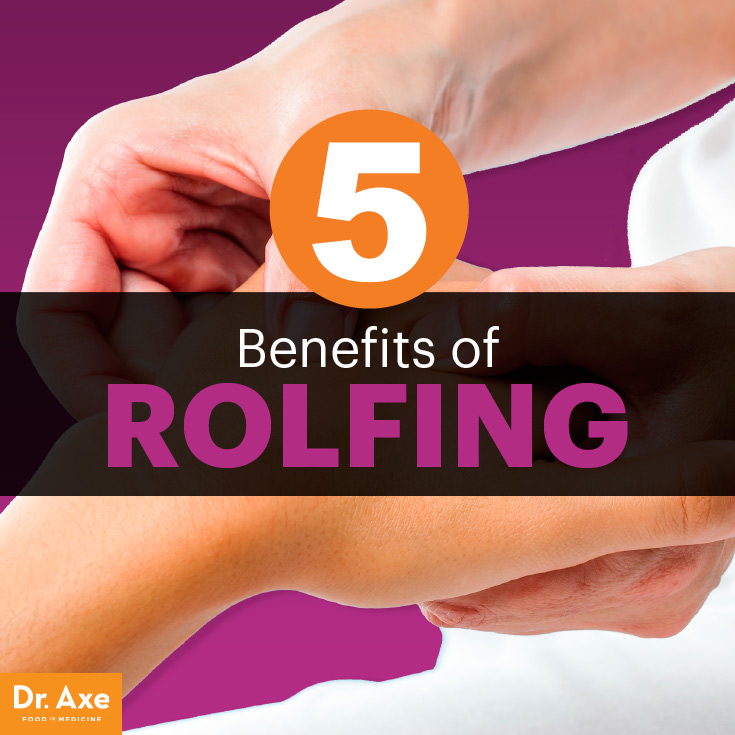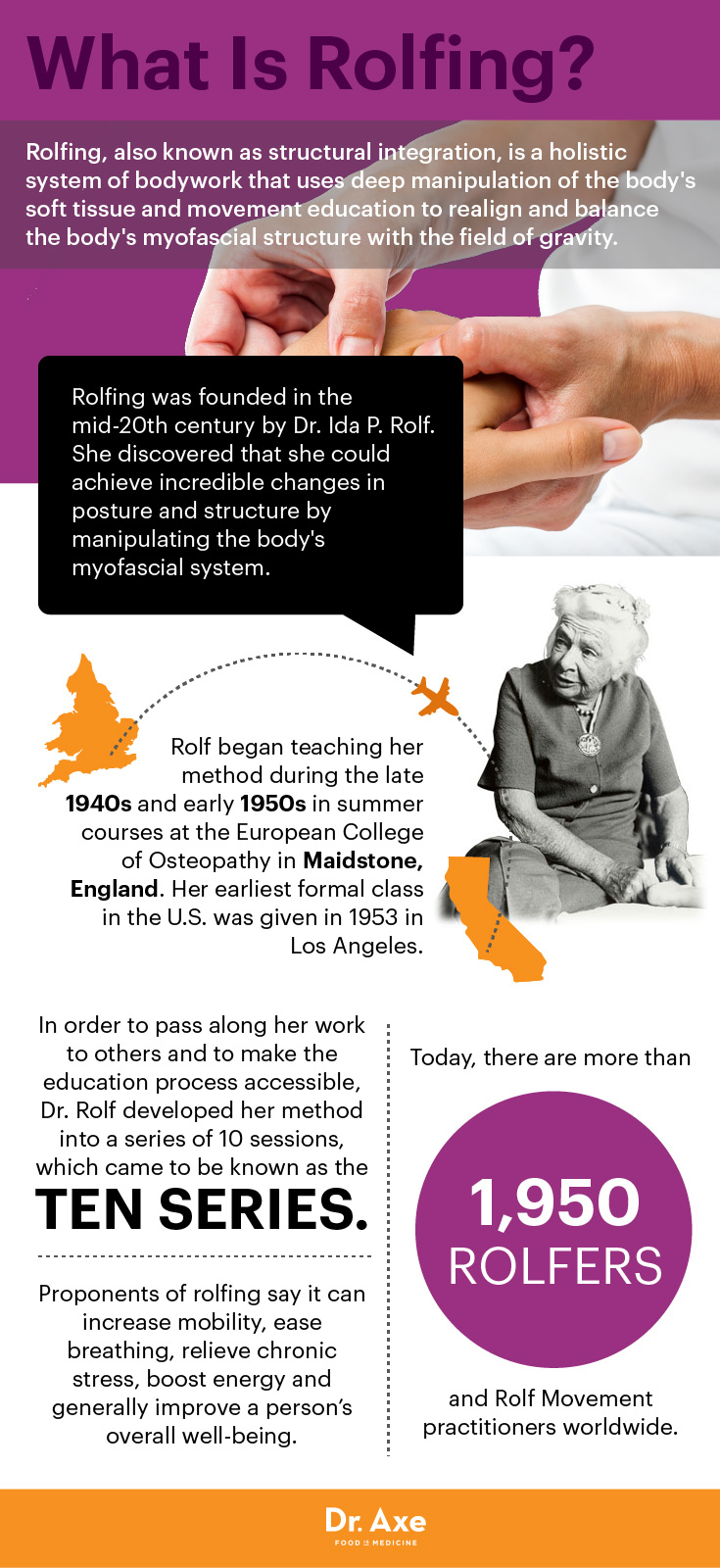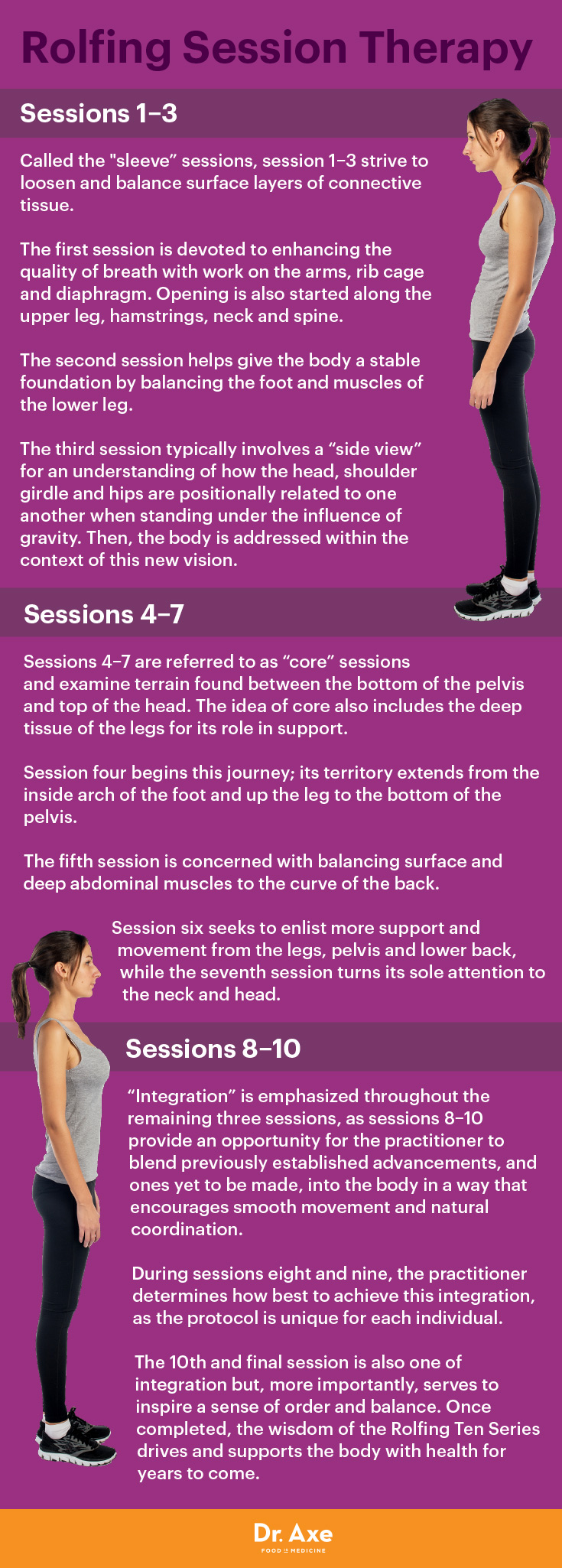Whether you’re 20 years old or 80 years old, rolfing can be beneficial for any body at any age. Rolfing, also known as structural integration, is a holistic system of bodywork that uses deep manipulation of the body’s soft tissue and movement education to realign and balance the body’s myofascial structure with the field of gravity.
It’s used to improve posture, relieve chronic pain and reduce stress. Rolfing focuses on the fascia, which is a band or sheet of connective tissue fibers in the body that forms beneath the skin to attach, stabilize, enclose, and separate muscles and other internal organs. It’s truly a holistic process of structural change that’s meant to not only improve physical well-being, but also emotional well-being.
Rolfing has been gaining popularity in recent years, but it has a long history of happy patients dating back to the mid-20th century, when it was founded by a true health pioneer and the greatest of all rolfers, Dr. Ida P. Rolf. Proponents of rolfing say it can increase mobility, ease breathing, relieve stress, boost energy and generally improve a person’s overall well-being. Rolfing also has a physiologic impact on the peripheral nervous system and on myofascial structures. Dr. Oz has even been rolfed on his showand said, “Rolfing literally releases the joints.” If you or someone you know suffers from any kind of chronic bodily pain or restriction, then you must read on!
5 Health Benefits of Rolfing
Dr. Rolf herself summed up the overall benefits of rolfing so well when she said:
“Some individuals may perceive their losing fight with gravity as a sharp pain in their back, others as the unflattering contour of their body, others as constant fatigue, yet others as an unrelentingly threatening environment. Those over forty may call it old age. And yet all these signals may be pointing to a single problem so prominent in their own structure, as well as others, that it has been ignored: they are off balance, they are at war with gravity. This is the gospel of Rolfing: When the body gets working appropriately, the force of gravity can flow through. Then, spontaneously, the body heals itself.”
Here are five impressive health benefits of rolfing:
1. Improves Athletic Ability
Rolfing for athletes focuses on changing their limiting physical behavior and educates them on how to use gravity in their favor. Rolfing can help athletes of all degrees gain improved physical ability by improving posture, lengthening constricted muscle fibers, relaxing areas of tension and improving ease of motion. By helping the muscles operate more efficiently, rolfing increases the body’s ability to conserve energy and develop more economical and refined patterns of movement for athletic activities, as well as everyday activities. At Arizona State University, Owen Marcus conducted the first study on performance and rolfing that documented the improved performance of elite runners as a result of being rolfed.
The Rolf Institute website has an impressive list of pro athletes who have benefited from rolfing, including: Michelle Kwan and Elvis Stojko, 1998 Olympic Silver Medal figure skaters; Phil Jackson, former Chicago Bulls and Los Angeles Lakers coach; Charles Barkley of the Houston Rockets; Rob Moore of the Phoenix Cardinals; Tim Salmon, Angels; the Phoenix Suns basketball team; Mario Lemieux of the Pittsburg Penguins; Bob Tewksbury, pitcher for the Minnesota Twins; Edwin Moses, Olympic track athlete; Joe Greene, 1996 U.S. Olympic Bronze Medal long jumper; and Ivan Lendl, former tennis champion.
2. Relief for TMJ
Temporomandibular joint syndrome (TMJ) is an inflammation and tightness of the joint that connects the jaw to the skull. You may know it better as jaw clicking, popping, locking and pain. Rolfing helps TMJ sufferers by releasing that joint between the jaw and skull from its restricted and painful state. Hence, the jaw can be relaxed and aligned properly again, moving smoothly without causing discomfort. Relieving TMJ through rolfing means you can have your jaw back in its original healthy state without invasive and often unsuccessful interventions.
A study published in the Journal of Bodywork and Movement Therapies, in which subjects suffering from TMJ were given 20 rolfing sessions, researchers concluded that rolfing increased the range of motion and reduced pain associated with TMJ.
3. Reduces Chronic Back Pain
Chronic stress kills your quality of life in several ways — for instance, it commonly causes tension in the back, shoulders and neck. These common bodily patterns of holding stress can be very difficult to break, but rolfing has been know to effectively correct these painful forms of tension. Rolfing can loosen the fascia, hence freeing up muscle movement and breaking bad patterns of muscle strain and misuse. This release should then enable the back to properly align itself, and when the back is properly aligned, back pain should recede.
Rolfing has been particularly successful as a remedy for fast back pain relief. Up to one-third of acute low back pain cases may become chronic. Structural integration (SI) or rolfing has been studied as an adjunct to outpatient rehabilitation for chronic, nonspecific low back pain, and outcomes suggest that adding SI to outpatient rehabilitation is likely to enhance reductions in low back pain-related disability and to increase patient satisfaction. Another study in the Journal of the American Physical Therapy Association supports the clinical use of rolfing’s soft tissue manipulation for certain types of low back dysfunction and musculoskeletal disorders associated with autonomic stress.
4. Improves Posture & Spine Health
Rolfing can be a beneficial treatment for posture problems, with studies showing effectiveness in the treatment of lumbar lordosis or curvature of the spine. Research has demonstrated that the holistic soft tissue approach of rolfing improves overall musco-skeletal balance and alignment. In addition, improvements in the parasympathetic nervous system were demonstrated that have been correlated with enhanced neurological function, including improved attention span as well as decreased levels of autonomic stress.
A study at UCLA had experimental subjects receive 10 sessions twice weekly for five weeks in alternating sessions by two rolfers. Both experimental and control subjects were evaluated before and after the five-week period. Researchers found that among clients who completed 10 sessions of rolfing compared to the control sample that had not received rolfing, those who participated in rolfing sessions had made consistent major improvement in efficiency of motor performance by improved organization and balance of the neuromuscular system.
Another study conducted to evaluate the use of rolfing to treat cervical spine dysfunction found that the basic 10 sessions of rolfing, when applied by a physical therapist with advanced rolfing certification, is capable of significantly decreasing pain and increasing active range of motion in adult subjects, male and female, with complaints of cervical spine dysfunction regardless of age.
5. Improves Asthma & Breathing in General
Asthmatics can consider rolfing as an asthma natural remedy. Evidence suggests rolfing can improve breathing for people with asthma. That’s because rolfing breaks up restrictive patterns in the fascia, nerves and muscles in the chest that limit full chest expansion for asthma sufferers.
People with respiratory disorders, such as asthma, can also benefit from the posture improvements that result from rolfing since restricted or incorrect breathing can create misalignments in the body that make breathing even harder. By improving breathing, rolfing can increase general feelings of well-being, reduces stress, improve energy levels and generally make life more enjoyable. If you have suffered from asthma or the breath-holding that can accompany anxiety, you know well what a difference healthy, full breathing can make in your daily life.
What to Expect at a Rolfing Session
To find your nearest rolfer, a certified practitioner of rolfing, you can visit www.rolf.org in the U.S. and www.rolfing.org. When attending a rolfing session, you should wear comfortable clothing that allows for easy physical movement. Each session is typically at least one hour and could possibly be two hours long. Each session aims to free restrictions or holding patterns stuck in a certain area of the body.
Rolf practitioners help their clients to become better aware of their current perceptual and movement responses, which are often restrictive and contributing to their pain. They then help clients explore the feeling of freer, more fluid movements during breathing, walking, bending, lifting and other basic daily physical actions.
According to the Rolf Institute® of Structural Integration the Rolfing® Ten-Series can be divided into three distinct units as follows:
Sessions 1–3
Called the “sleeve” sessions, session 1–3 strive to loosen and balance surface layers of connective tissue.
Specifically, the first session is devoted to enhancing the quality of breath with work on the arms, rib cage and diaphragm. Opening is also started along the upper leg, hamstrings, neck and spine.
The second session helps give the body a stable foundation by balancing the foot and muscles of the lower leg.
The third session typically involves a “side view” for an understanding of how the head, shoulder girdle and hips are positionally related to one another when standing under the influence of gravity. Then, the body is addressed within the context of this new vision.
Sessions 4–7
Sessions 4 –7 are referred to as “core” sessions and examine terrain found between the bottom of the pelvis and top of the head. The idea of core also includes the deep tissue of the legs for its role in support.
Session four begins this journey; its territory extends from the inside arch of the foot and up the leg to the bottom of the pelvis.
The fifth session is concerned with balancing surface and deep abdominal muscles to the curve of the back.
Session six seeks to enlist more support and movement from the legs, pelvis and lower back, while the seventh session turns its sole attention to the neck and head.
Sessions 8–10
“Integration” is emphasized throughout the remaining three sessions, as sessions 8–10 provide an opportunity for the practitioner to blend previously established advancements, and ones yet to be made, into the body in a way that encourages smooth movement and natural coordination.
During sessions eight and nine, the practitioner determines how best to achieve this integration, as the protocol is unique for each individual.
The 10th and final session is also one of integration but, more importantly, serves to inspire a sense of order and balance. Once completed, the wisdom of the Rolfing Ten Series drives and supports the body with health for years to come.
Rolfing History & Interesting Facts
Rolfing is named for its founder, Dr. Ida Rolf, an American biochemist who spent her life exploring the healing possibilities held within the human mind and body. Ida obtained her bachelor’s degree from Barnard College in 1916 at the age of 20. She then went on to earn her Ph.D. in biochemistry from the Columbia University College of Physicians and Surgeons.
Looking to find solutions to her own health issues as well as those of her loved ones, Rolf went on to spend many years studying and experimenting with different systems of healing and manipulation, including chiropractic medicine, osteopathy, homeopathy, and mind-body disciplines such as yoga, the Alexander Technique and Alfred Korzybski’s theory of general semantics.
As she learned from all of her experience and research, Dr. Rolf discovered that she could achieve incredible changes in posture and structure by manipulating the body’s myofascial system. She eventually named her approach “structural integration” and began teaching her method during the late 1940s and early 1950s in summer courses at the European College of Osteopathy at Maidstone, England. Her earliest formal class in the U.S. was given in 1953 in Los Angeles. During this early period, Rolf also traveled extensively, demonstrating her methods to groups of chiropractors and osteopaths.
Dr. Rolf’s intention was always to bring her method to as many people as possible and to pass on her knowledge to future generations. In order to pass along her work to others and to make the education process accessible, Dr. Rolf developed her method into a series of 10 sessions, which came to be known as the Ten Series. Clients and practitioners dubbed Dr. Rolf’s work “rolfing,” and the name stuck. Since her death in 1979 at the age of 82, the Rolf Institute® of Structural Integration has continued to share Dr. Rolf’s work by certifying Rolfers™ and Rolf Movement® Practitioners, supporting research, and building upon her inspiration. Today, there are more than 1,950 Rolfers™ and Rolf Movement® Practitioners worldwide.
Rolfing is also used on children, and it is even being offered for horses (“equine rolfing”). When it comes to kids, some parents use rolfing to help manage cerebral palsy (CP), a broad term used to describe a group of chronic “palsies” or disorders that impair control of movement due to damage to the developing brain. CP is one of the most common causes of chronic childhood disability. When combined with traditional therapy, some doctors believe that rolfing can help reduce the need for more invasive treatments of cerebral palsy.
Rolfing’s Relationship to Other Therapies
Rolfing is often mistakenly thought of as a type of very deep tissue massage. While rolfing and massage both involve soft tissue manipulation, rolfing also aims to balance the body in gravity by improving the body’s physical balance.
As previously mentioned, Dr. Rolf was influenced by yoga as she developed rolfing so it comes as no surprise that rolfing and yoga are complementary to one another, both helping to improve the body’s flexibility, balance and overall structure. Rolfing and yoga are similar in how they both look at the body as a whole, recognizing that improving physical well-being helps to improve emotional well-being and vice versa. Both yoga and rolfing focus on guiding the breath gently and fully throughout the body to release tension while improving energy levels and flow.
Rolfing: Possible Side Effects and Caution
It is important to make sure that any chronic discomfort or pain is not caused by an underlying health issue so having a general physical with your doctor prior to beginning a rolfing program is a wise idea. Anyone with an illness, infection or injury should be cleared by a doctor prior to attending a rolfing session. Also, consult your doctor first if you have any connective tissue disorder, are pregnant or nursing, or have a psychological disorder. Rolfing may not be recommended for people under these circumstances.
Some people do find rolfing to be painful at times, especially in the early sessions before the tissue releases. The level of discomfort one might experience during a rolfing sessions depends on several factors, including the degree of trauma to the system, how long that trauma/pain has been in the area of the body, and how emotionally linked the pain or injury might be for the individual. Rolfing practitioners vary in their general levels of intensity. They also vary their intensity as needed on a client-by-client basis. Some long-held, deep pain likely requires greater intensity, which can result in some discomfort, but similar to massage, the discomfort is momentary and typically well worth it. Any discomfort typically turns to pleasant sensations as the body releases and relaxes more and more with each session.
Some soreness can be experienced after a rolfing session, but it is usually mild and responsive to basic heat and ice treatment. Hydration before and after a rolfing session is always recommended and helpful.
Rolfing is generally believed to be safe for most people. However, anyone with cancer or an illness that can be spread with increased circulation should refrain from rolfing or any other form of deep tissue manipulation. Additionally, anyone with a blood-clotting issue or anyone taking blood thinners should also avoid rolfing. Check with your doctor before starting a rolfing regiment if you have any ongoing health concerns.
Source: Dr Axe








